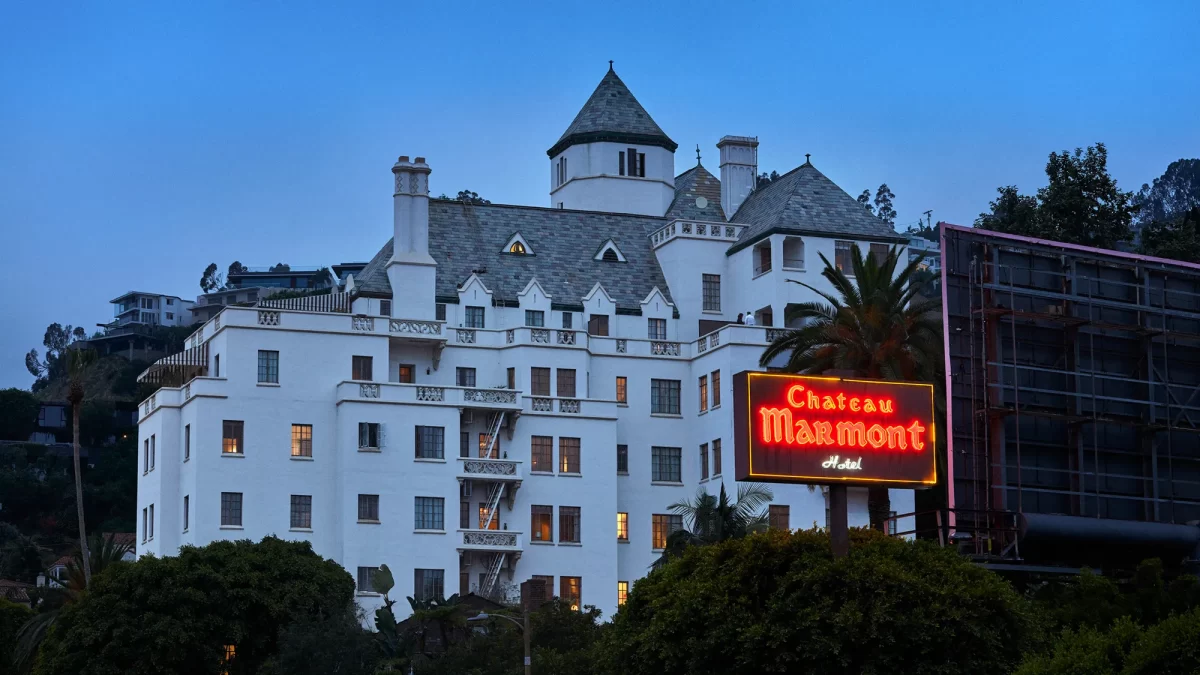By Tilly Bridgeman
‘It has been the site of wild parties and scandalous liaisons, of creative breakthroughs and marital breakdowns, of one-night stands and days-long parties, of famous triumphs and untimely deaths.’ The Castle on Sunset, Shawn Levy.
The year 2020 saw major punctures made to physical spaces of creativity, with communities being fragmented by lockdowns and individuals seen only as a mass of blue masks marching in search of loo roll. Over the past four years, the deflation of creative endroits has persisted, with online artistic engagement superseding escapades to the cinema, art galleries, opera house – the list goes on.
Yet, a Richter scale ticks on the outskirts of Hollywood’s hills, picking up pulses of creativity coming from a neon red sign and a grey slate roof. ‘The grande dame of Sunset Boulevard’, it named itself in a recent Instagram post; over the course of nearly 100 years, Chateau Marmont has become the space for creativity.
If pressure makes diamonds, then it is a similar sense of tension, so evident in Shawn Levy’s lines taken from The Castle on Sunset, that generates the glinting artistic pieces conceived at the Chateau. The debauched and the intimate, the striking and the simple, the chic and the shabby; contrast defines Chateau Marmont, and it is at this strange intersection of opposing forces that a space of innovation emerges. This seedy wonderland was where photographer Helmut Newton captured Michelle Pfeiffer for Vogue, and was himself caught in a tragic car accident twenty years later. It is the castle in which the young and in love Sharon Tate and Roman Polanski moved to, after their wedding in 1968, yet also where Polanski, alone, would spend his last night in the US following his wife’s murder in 1969. It was at once a hideaway for Nicholas Ray, affected by an incident involving his son and second wife, and the fertile ground from which grew his Rebel Without a Cause.
Contradiction, right down to the Chateau’s architecture – mid century suites set against an imposing turret – paves the way for artistic upheaval. In conjunction with this permeating sense of incongruity is Chateau Marmont’s ability to amass a vast array of individuals, generating a kind of “safe space” for creativity. Congregation seems to be an apt word, a congregation of thoughts, of personalities, of arts. The Chateau lit the flames of Sidney Poitier and Diahann Carroll’s nearly decade long affair during their filming of Paris Blues. In 1938, Humphrey Bogart welcomed his mother into one of the suites. More recently, Jay Z and Béyonce ordered the conversion of the garage into a one-time casino for their 2019 Oscars after party. Romantic pursuits, family gatherings, friends (and enemies) all exist in this sphere of imaginative conception.
Would Shakespeare have found himself at the Chateau? I am not too sure, but I will use his lines from Romeo and Juliet to conclude my point. ‘What’s in a name?’, well, in the case of Chateau Marmont, perhaps everything. Architect Arnold A. Weitzman, in the 1920s, was commissioned by owner Fred Horowitz to build something along the lines of the Chateau d’Amboise, a former cache for French royalty. Yet, when it came to christening the castle, “Chateau Hollywood” was rejected, and in its place the smaller Marmont Lane stood. A chateau and a roadside hotel, where the regal collides with the sordid, and the minds of ninety vibrant years have met and continue to meet.
And so, while Gore Vidal drapes Myra Breckinridge over one of the loungers by the pool and John Belushi fiddles with needles in his bungalow, Gucci’s Alessandro Michele takes the mascot of Pan and his pipe on a stroll down the runway, and Sofia Coppola pushes Stephen Dorff out of the door and into Somewhere, the light of creativity on this Sunset Boulevard Chateau never seems to set.

